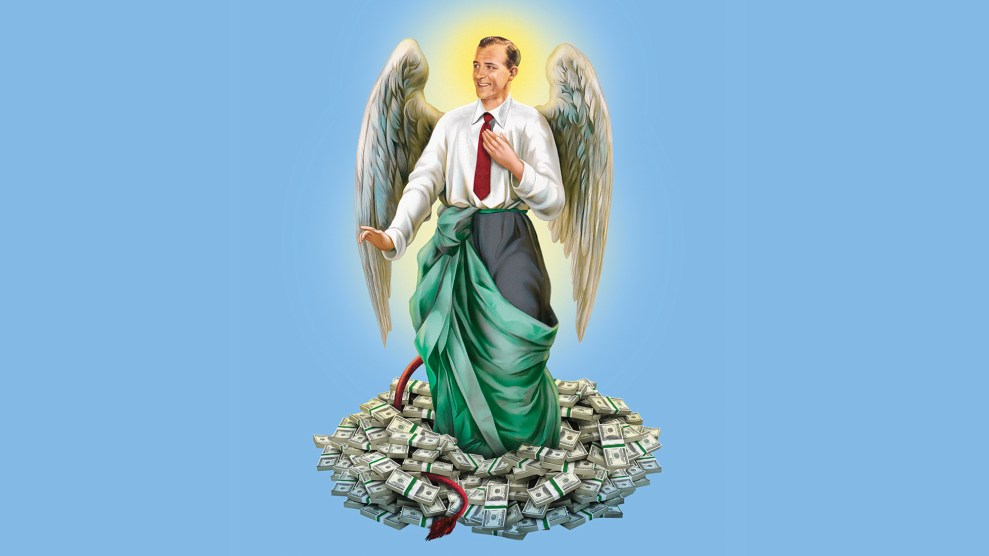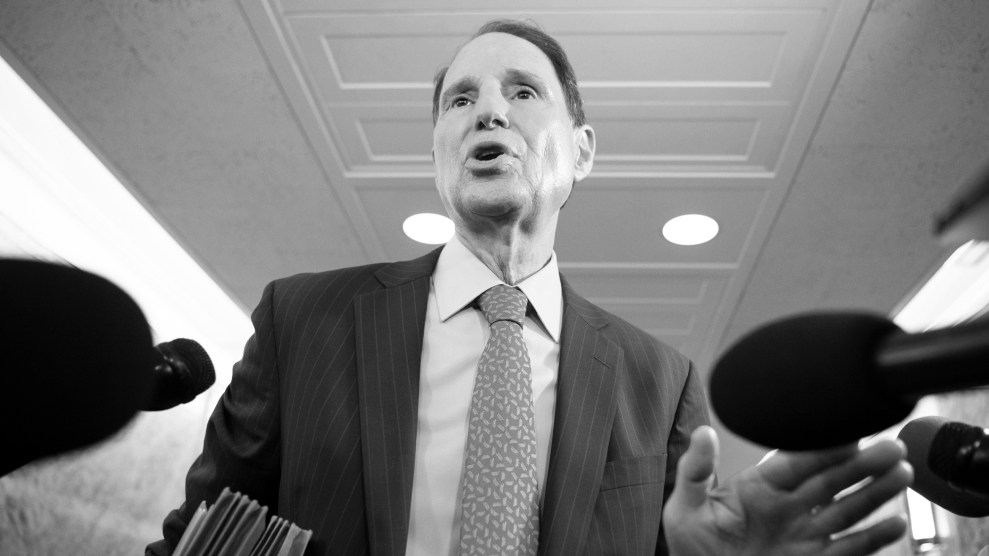When the US targeted Russia’s oligarchs after the invasion of Ukraine, the trail of assets kept leading to our own backyard. Not only had our nation become a haven for shady foreign money, but we were also incubating a familiar class of yacht-owning, industry-dominating, resource-extracting billionaires. In the January + February 2024 issue of our magazine, we investigate the rise of American Oligarchy—and what it means for the rest of us. You can read all the pieces here.
On an overcast Wednesday in July 2020, a ragtag collection of 100 or so demonstrators converged outside the Southampton, New York, mansion of billionaire media mogul and former NYC mayor Michael Bloomberg. The nation was reeling from Covid lockdowns and months of unrest over police violence. The state’s billionaires, though, were clocking massive gains—almost $47 billion collectively during the pandemic’s first two months alone.
The protesters, some of whom carried plastic pitchforks and referred to Bloomberg as a “looter,” according to the local daily, were demanding that billionaires pay more taxes—and rightly so. Berkeley economists Gabriel Zucman and Emmanuel Saez had recently calculated that the combined taxes paid by the nation’s 400 top earners amounted to 23 percent of their incomes, well below the national average of 28 percent. The crowd eventually moved down the road for a repeat performance at the estate of private equity billionaire Stephen Schwartzman, Blackrock’s CEO.
This rare breach, by the rabble, of a notable haven of the super-rich, served as a stark reminder of the perils that might await the Rolex-and-Balenciaga crowd should the natives get too restless. “We fielded a lot of calls from the Hamptons today,” 61-year-old Tom Gaffney, whose livelihood relies on upper-crust anxieties, told me the day after the Southampton mini-uprising.
Gaffney, a minor character in Jackpot, my recent book about wealth in America from which this article is adapted, is the go-to guy for plutocrats seeking a hedge against the unthinkable—a luxury space that can be transformed, with the push of a button, into a pampered fortress, a haven safe from armed invaders, deranged stalkers, would-be kidnappers, and resentful Occupy mobs.
Saferooms writ large are neither posh nor uncommon. Freestanding ones, deployed as shelters in tornado country, can be had for a few thousand bucks. But Gaffney caters to clients who think nothing of shelling out up to $500,000—more than America’s median home price—to armor a master bedroom with Kevlar plates and blast-resistant doors.
Gaffney’s residential units boast the same FEBR (forced entry ballistic rating) as saferooms in US embassies overseas. They can withstand a minimum of 30 minutes of sustained attempts at forced entry and handle a barrage of AR-15 or AK-47 fire. The best part, “the beauty of the saferoom, the way we build them,” he says, “you don’t even know they’re there.”
You may never need them, either. The odds of falling victim to violent crime declines with rising household income, and the wealthiest zip codes are about as safe as it gets. But the natives are restless. A 2021 Pew survey found that the public viewed billionaires more negatively than before the pandemic—nearly one-third of the respondents, half of the 18-29 age cohort, and even 14 percent of the Republicans surveyed, said the very existence of billionaires was bad for America. One super-rich private equity guy I interviewed for the book told me he didn’t really think the system was unfair, but said he’d been thinking increasingly about inequality: “I’m thinking they could come and burn my house down.”
Although Gaffney cannot discuss clients by name—“that’s suicide”—he estimates he’s built between 200 and 300 saferooms, mostly in the United States, but also in places like Jordan, Nigeria, and Mexico, and Saudi Arabia—“I’ve done work for princes and presidents,” he says. Some of his clients are well-known musicians and Hollywood stars concerned about the random “wack job.” But his bread and butter is Wall Street billionaires. “Take a look at America’s top 20 hedge-fund performers, “I guarantee I’ve done work for 10 of them,” Gaffney says.
Spending hundreds of thousands of dollars to harden a bedroom against a very-low-probability scenario may sound absurd, but to these Masters of the Universe it’s the equivalent of a middle-class family installing a basic alarm system. In a lot of these homes, “there’s an underground pool, there’s an underground movie theater, there can be basketball courts. It’s truly amazing,” Gaffney says. The hedge-fund guys, he adds, often employ former Secret Service or FBI agents as consultants, men who think “the way the government thinks: lockdown.” Besides, hedging against perceived risk is what these guys do for a living: “If they’re building a $50 million or $100 million house, it’s a smart investment.”
Gaffney’s earliest projects involved the opposite end of the wealth spectrum. In the early ’80s, he left his quiet hometown of Sligo in northwest Ireland for New York City. He had some construction skills, and so a cousin who worked for a regional check-cashing company landed him a job building new outlets in the bruised sections of the Big Apple. The tellers sat inside a “prehistoric” saferoom, Gaffney says—a metal box: “It was just sprayed steel plates: Put them up on the walls, put in the ballistic glass and the ballistic doors, the man trap, and that was it.”
Before long, he found himself designing the bulletproof wood-and-glass “bandit barriers” that were coming into vogue at retail banks like Chase and Citibank. He began outfitting post offices as well, and Gaffco Ballistics, which he launched in 1986, had no shortage of work.
What really changed the game, though, was 9/11. Up until then, Gaffney had built maybe 10 saferooms, he says. Suddenly everybody wanted them, from federal agencies to Wall Streeters who’d witnessed the terrorist attacks firsthand “I think 9/11 was a wakeup call,” Gaffney says. “They became more aware about security—or lack of security—in the world.” In its aftermath, he landed a series of federal contracts to build saferooms at government installations abroad. The residential aspect picked up upon his return, as hedge-funders and other wealthy individuals sought him out to secure not only their offices but their multiple estates.
Gaffney, who has since relocated his workshop to small-town Vermont, doesn’t advertise and doesn’t need to. The word gets around, and his projects run the gamut. Fortified wine rooms are popular. One client in Greenwich, Connecticut, “had about $2 million or $3 million worth of wine,” Gaffney says. “It was a huge cellar. We lined all the walls with ballistic fiberglass, the door as well. His whole thing was, when he went out, he wanted to go out drunk.”
A dirty bomb—which has never been deployed anywhere, ever—is apparently among the scary scenarios that keep some urban billionaires up at night. Gaffney will armor up the client’s home theater and equip it with sophisticated air purifiers that can filter out radiological, biological, or chemical contaminants: “You’ve got your food, you’ve got your water, and you’ve got communications: satellite phone, dedicated phone line—of course you’ve got your computers, you’ve got CNN, you got everything else on your screen. And your backup power. Everything is redundant,” he says.
His approach to safe-room building was inspired by his own experiences. During Operation Iraqi Freedom in the mid-2000s, the US government hired his crew to armor trucks that protected convoys running between Baghdad and Kuwait. “We slept with guns in the bed because we weren’t in the Green Zone,” he remembers. But just being armed wouldn’t cut it, he realized. “You’re sound asleep in your bed. You might have had a couple of glasses of wine or a sleeping pill,” he says, whereas the guys coming to break into your house are likely to be alert, prepared, and on a mission, and “unless you’re trained like these special ops guys, you’re not going to respond correctly.”
That’s why Gaffney almost never builds a standalone saferoom like the one in that 2002 Jodie Foster thriller. “It was fine in Panic Room,” he says, but in his view the room will only work in an emergency if it’s a space the client uses every day. Push a special button concealed inside, and electromagnetic locks will deploy in the door and frame, sealing off the client from any adversary.
Customers increasingly opt to fortify an entire wing of their home, because just doing the master bedroom would leave the kids exposed. One client in Nigeria “spent a million bucks,” Gaffney says. “Every door and every window of the residence was ballistic. And it was a stone house, so basically the whole house became a safe room.” Families with rural getaways have had him build escape tunnels in case the local 911 response proves too slow.
Even amid all of this haute paranoia, some client requests have struck him as excessive. “A lot of times they’ll do the walk-in closet, but behind the cabinetry they’ll have a door into a small area, and they’ll put a gun port in the door so they can return fire,” Gaffney says—a saferoom within a saferoom. He’s also been surprised by the size and scope of the billionaires’ arsenals. “Growing up in Ireland, we didn’t have guns,” he says. “The weaponry I’ve seen in some people’s houses matched what I’ve seen in Iraq.”
Another Greenwich client asked for a sniper’s nest for his attic. “He wanted to get the guys coming up the driveway. I said to myself, You’re mad!” Gaffney recalls. “You just can’t be up there in a sniper’s nest and shoot people! But this is an extremely wealthy guy. This is what he wants to do.”
Fortunately, somebody talked the billionaire out of it.
















